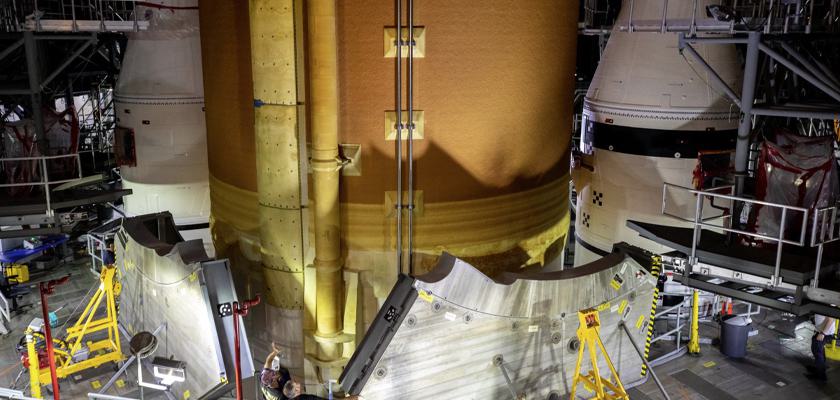NASA managers responsible for the final preparations to launch the world’s mightiest rocket provided a work progress update during a press conference that began an hour late Thursday, due to President Joe Biden’s address to the nation regarding the Ukraine crisis.
Marshall Space Flight Center in Huntsville was responsible for developing the Artemis I rocket which, if all preparations go well, could be ready to launch sometime between May 7th and May 21st, at which time the Kennedy Space Center Florida launch site and the Moon will be aligned for the planned uncrewed test flight to the Moon.
The journey to the Moon for the 322-foot tall, 8.8 million pound thrust moon rocket will begin at the snail’s pace of one-tenth miles per hour when the rocket is carefully transported to the launchpad through the giant 456-foot-tall Vehicle Assembly Building (VAB) doors on St. Patrick’s Day, March 17. Mike Bolger, the NASA Exploration Systems Program Manager cohosted the teleconference and told reporters that, “The Crawler Transporter will transport the over 17-million-pound stack to launchpad 39-B and the top of the ML (Mobile Launcher) umbilical tower will be about 400-feet off the ground when it's riding on top of the Crawler Transporter, so it’s going to be a sight.”
If the St. Patrick’s Day luck of the Irish holds out, the launchpad checkout and “wet testing,” as NASA Deputy Administrator for Exploration Systems Tom Whitmeyer described the rocket fueling and simulated countdown testing on the launchpad to be conducted at the pad, Artemis I will have passed a major milestone in America’s effort to sustain its role as the global leader in space exploration that was wrested from the Soviets during the space race of the 1960s when NASA beat the Russians to the Moon.
The rollout of Artemis I is a four-mile, 11-hour journey to the launchpad at a cruising speed of .82 miles per hour. After the conclusion of initial pad testing, the Artemis I rocket will roll back to the 500-foot tall VAB for final preparations for a possible May launch to the Moon. Whitmeyer reported that “The hardware has performed very well.”, during the final pre-rollout test conducted inside of the 50-story tall VAB, and that, “By completing that test, that gives us the opportunity to closeout the vehicle and prepare it for roll.”
According to Mike Sarafin, the Artemis I mission manager at Thursday’s press conference, Huntsville engineers at Marshall will also play an active role during the testing as well as on the actual launch day as a vital part of the launch support team from their consoles in Huntsville. Sarafin described the final portion of the simulated countdown portion of the launchpad wet testing. “We’ll do a manual (countdown) cutoff at 9.34-seconds (before launch) which is just before we ignite the RS-25 engines, so we’re going to get very late in the count purposefully and demonstrate all the interfaces.”
Artemis I will shake the ground for miles around with its 8.8 million pounds of thrust when it finally launches within full view of what will probably be one of the largest in-person crowds of rocket launch viewers in history as it will be a launch physically felt as much as it will be seen with the eyes and heard with the ears.
Artemis I is the rocket that will take humans back to the Moon for the first time in more than 50 years and will later send the first human explorers to and back from Mars.
To connect with the author of this story, or to comment, email Jim.McDade@1819News.com.










